British Colonial Nassau dates back more than a century.
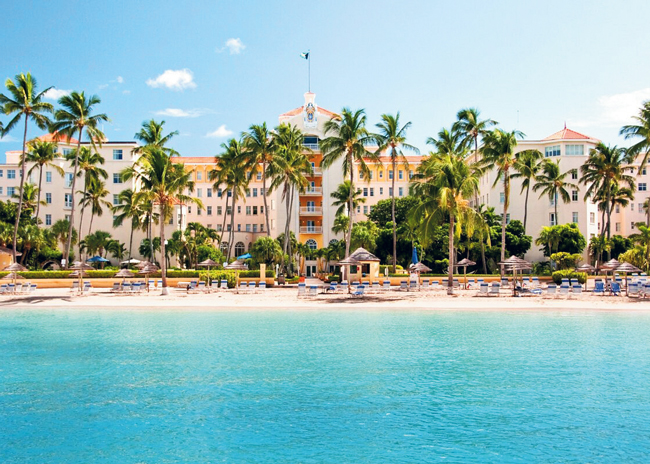 The Bahamas property was originally financed by oil and railroad tycoon Henry Flagler. The hotel opened in 1901. It burned down in 1922, leading to the construction of what was named New Colonial Hotel, which opened in 1924. Then in 1932, Sir Harry Oakes bought the hotel, reportedly on a whim after being asked to leave the premises for not dressing properly. He renamed it the British Colonial Hotel. Oakes was murdered in 1943 in an unsolved mystery. In the following years, the hotel was managed by Sheraton, Best Western and Hilton. In 2014, China Construction America (CCA) acquired the property. The hotel closed in 2022 while it underwent a $50-million renovation. It reopened in December 2023.
The Bahamas property was originally financed by oil and railroad tycoon Henry Flagler. The hotel opened in 1901. It burned down in 1922, leading to the construction of what was named New Colonial Hotel, which opened in 1924. Then in 1932, Sir Harry Oakes bought the hotel, reportedly on a whim after being asked to leave the premises for not dressing properly. He renamed it the British Colonial Hotel. Oakes was murdered in 1943 in an unsolved mystery. In the following years, the hotel was managed by Sheraton, Best Western and Hilton. In 2014, China Construction America (CCA) acquired the property. The hotel closed in 2022 while it underwent a $50-million renovation. It reopened in December 2023.
The property, including its food operations, had lost its attraction for a new generation of guests and visitors. Hotel and dining competition in Nassau is fierce as more high-end hotels have been built in recent years. At British Colonial, renovations of the 228-room hotel began in the fall of 2022. The project required phasing, so dining operations began opening in December 2023, and nearly all opened in May 2024.
The renovated property features dark wood cabinetry and geometric tiling that reflect the Roaring ’20s. Common areas also reflect the Colonial Revival architectural style with dark mahogany furnishings, original crown moldings, massive chandeliers and murals that depict Bahamian history. Hotel guests use oceanfront pools facing a 300-foot private beach. Guests also have access to more than 18,000 square feet of indoor and outdoor space for meetings of up to 800 guests.
“The owner wanted to bring this marquis hotel back to life, reviving it to its former glory,” says John Egnor, managing partner, JME Design, Columbus, Ohio. JME Design served as the foodservice consultant for this project. “The dining team’s goals, in keeping with the entire hotel’s renovation team, were to maintain an old-world charm while presenting a modern version of a classic hotel deeply ingrained in the fibers of Nassau.”
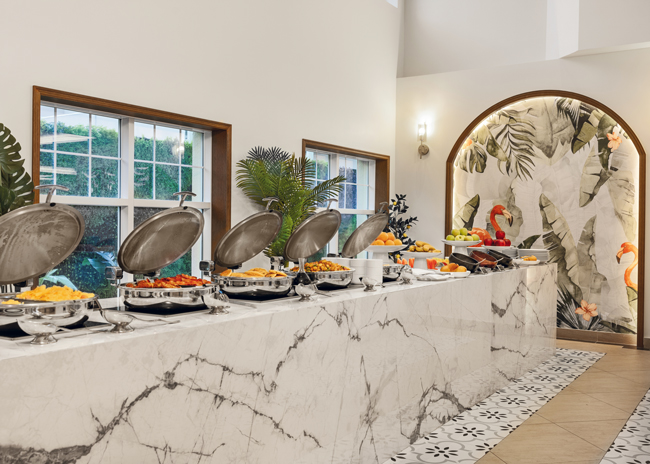 Photos courtesy of John Egnor
Photos courtesy of John Egnor
All the furniture is new, but it is in the same style as the 1920s, notes Michael Cloutier of Fort Meyers, Fla. The independent consultant served as part of the project team and provided consultation on operations’ design, specifications and purchasing of everything from furniture to equipment.
Renovated food and beverage sites include Woodes Rogers Tavern (martini bar, hand-crafted cocktails, wines by the glass, light meals and snacks); Mahogany Club (1920s supper club featuring Italian cuisine with Caribbean and Bahamian influences); Tamarind Market Place (buffet restaurant); Sakana Noodle & Sushi Bar; British Colonial Trading Company (coffees, teas, pastries, doughnuts and breakfast sandwiches); a production kitchen; and a staff cafeteria. On the second floor, renovations included a banquet kitchen and pantries and The Pointe Pastry, which is a shared pastry laboratory.
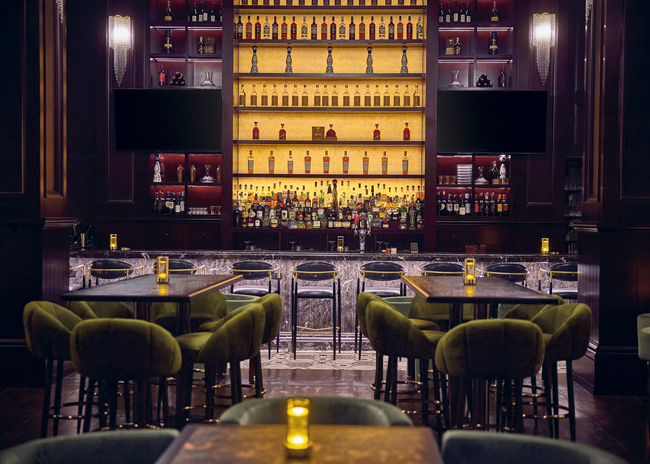
“Not many of the interior finishes were changed at the Woodes Rogers Tavern and the Mahogany Club, while the others were designed to be more contemporary to create an ambience of a modern resort in a very competitive market with resorts such as The Cove at Atlantis, Rosewood Baha Mar and Margaritaville Beach Resort,” says Ian Bushong, project manager, JME Design. “The goal was to position different restaurants and bars in close proximity connected by walkways in order to create a community in which hotel guests and visitors coming from cruise ships have a multitude of choices.”
Challenges presented themselves along the way, which is a common occurrence in renovations. For instance, the kitchens had been periodically renovated, and specific pieces of equipment had been replaced, but the infrastructure had not been updated since the original construction. “We had to update and rewire all the mechanical, electrical and plumbing systems and redo all the fire safety systems,” says Cloutier.
Looking more closely at the foodservice operations, “an exhaust duct that was presumed to be in acceptable condition was discovered and had perforations from age and environmental deterioration, so it had to be replaced,” Bushong says. “Some of the equipment had been replaced over the years, but what was in place before the renovation couldn’t be used or refurbished because parts weren’t available, or the frame wasn’t structurally in sound condition and didn’t hold up when it was moved.”
Indeed, plenty of thought and detail went into updating a 120-year-old property to allow it to keep its historical relevance and charm. “Being able to address these issues requires a team effort, and that is what makes a renovation project successful,” Egnor says. “The ownership team was able to provide clear direction about the goal of the renovations, and when items needed to be resolved, they stepped up and moved the project forward.”
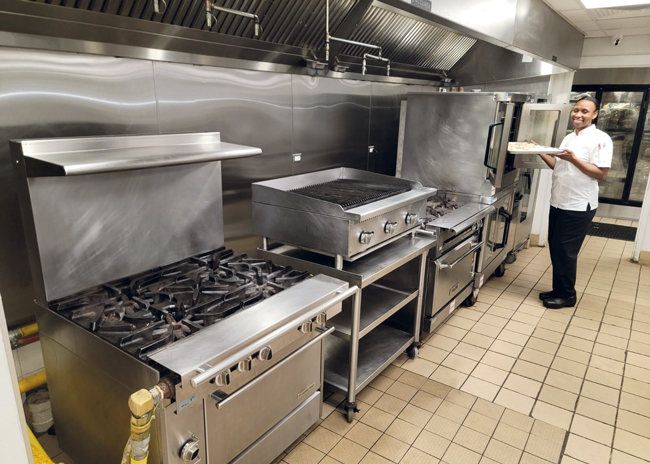 Pastry chef Geshann Pratt places a dessert in the convection oven in the main kitchen.
Pastry chef Geshann Pratt places a dessert in the convection oven in the main kitchen.
Production Flow
After food deliveries arrive at a loading dock, staff place them in one of five walk-in coolers, a walk-in freezer or dry storage. “Each day, culinary staff requisitions menu items they need for their stations,” says Ignazio Podda, executive chef.
The kitchen and a la carte cooking lines support all the restaurants except Sakana Noodle & Sushi Bar, which has its own production area. Guests watch as culinary staff prepare sushi and sashimi and dish out rice from rice cookers. A noodle bar-style display allows guests to select their own pasta and sauces. Staff transport all food for Tamarind Market Place, a buffet-style restaurant, from the kitchen using hot and cold holding carts. Guests at Tamarind Market Place can watch culinary staff prepare menu items, such as omelets on induction burners, waffles in a waffle maker and toast in a conveyor toaster. A carving station contains five induction chafing dishes to hold bacon, sausage and scrambled eggs.
In the cold prep area, staff prepare ingredients for menu item production in the restaurants, cafeteria and banquet kitchen. For example, they use slicers and a buffalo chopper to make salads served in Mahogany Club, including Caesar salad, insalata caprese and a salad with mixed greens, roasted beets, toasted almonds, shaved onions, cherry tomatoes, charred corn, goat cheese and Tahini-lime dressing. Appetizers, such as beef carpaccio and spicy Jamaican clams, are also prepared here. Staff also use 12-quart and 20-quart mixers for making dressings and mincemeats.
At a nearby hot line, staff use a combi oven to cook proteins, a double-deck and single convection oven to heat proteins and vegetables, an infrared broiler to cook proteins and a four-burner range to prepare sauces for a lobster thermidor before it is placed in the combi oven for finishing.
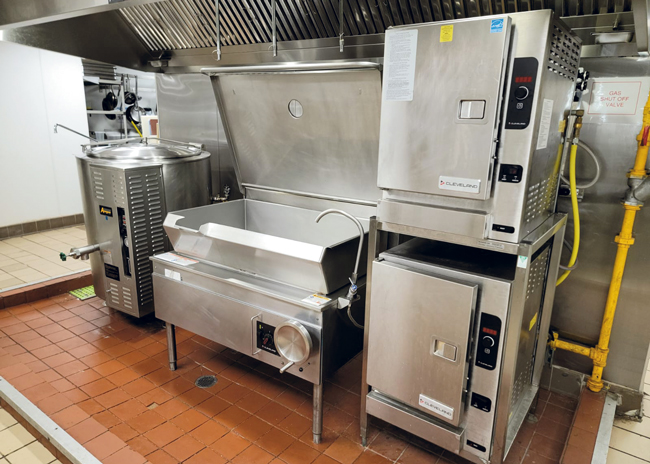 A kettle, tilt skillet and convection steamers allow culinary staff to efficiently prepare menu items for the restaurants. Photos by Ignazio PoddaUnder a separate hood reside a double-decker pressurized convection steamer for vegetables and meats such as corned beef for Reuben sandwiches. Staff use a tilt skillet for rice, stews and soups and a steam-jacketed kettle for stocks. Also in the preparation area, staff cook pasta and vegetables in a convection steamer and sauces and soups in a 60-gallon kettle.
A kettle, tilt skillet and convection steamers allow culinary staff to efficiently prepare menu items for the restaurants. Photos by Ignazio PoddaUnder a separate hood reside a double-decker pressurized convection steamer for vegetables and meats such as corned beef for Reuben sandwiches. Staff use a tilt skillet for rice, stews and soups and a steam-jacketed kettle for stocks. Also in the preparation area, staff cook pasta and vegetables in a convection steamer and sauces and soups in a 60-gallon kettle.
The dishwashing area separates this part of the prep kitchen from the restaurant prep kitchens. A conveyor dishwasher allows staff to load and unload quickly throughout the day.
A la carte lines support the restaurants, as well. Staff prepare steaks, burgers and fish on a charbroiler and flattop griddle. They use a double fryer for menu items such as mozzarella croquette and chicken wings. A rapid-speed oven allows staff to heat flatbreads. “Eventually, we’ll open up a trattoria, and flatbreads will be a perfect menu item here,” Podda says.
On the second floor, the banquet kitchen and pastry shop support all catering functions taking place in three separate ballrooms with seating capacity from 180 to 300. Combi ovens, deck ovens, ranges and a chargrill support the banquet menu entrees. The pastry shop supports production of all special desserts, sugar work, chocolate and gelato. Staff in the pastry shop use a sheeter, triple-deck convection oven, chocolate tempering heater, a gelato back freezer and mixers and related bakery equipment.
 A chef prepares sushi and sashimi at Sakana Noodle & Sushi Bar.
A chef prepares sushi and sashimi at Sakana Noodle & Sushi Bar.
Challenges and Benefits
Unlike many restaurant kitchens in the U.S., those at the British Colonial will not move toward all-electric functioning. “Electricity is extremely expensive here,” Egnor says.
Soon, the culinary team will begin using an on-site butcher shop. They’ll also use sous vide production and vacuum pack menu items, including seafood (such as conch, octopus and local fish), pork cuts, poultry and vegetable infusions.
“Our best aspects of this operational area also are most challenging,” Podda says. “We’re well centralized, but the space is tight to be producing so much food for the different venues. But we work as a team and make sure we are well prepared.”
Preserving the flavor of a historical property, while modernizing menus, keeps the British Colonial Hotel continuously challenged. As this area of the Bahamas grows and attracts more tourists, this blend of the past with the present gives guests at the property a unique experience.
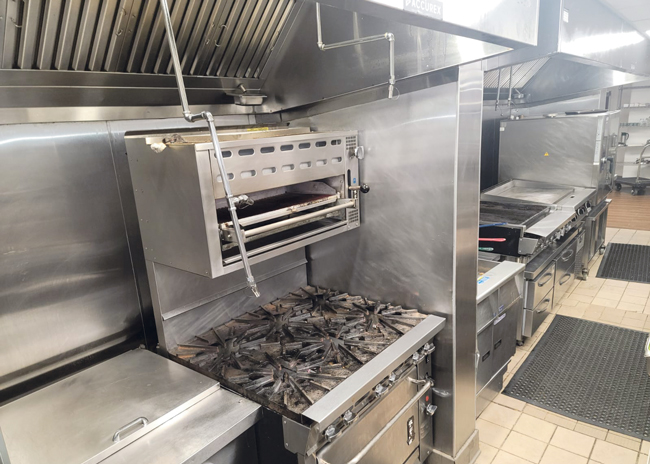 A hot line contains a range, a salamander, fryers, a charbroiler, a flattop griddle, a convection oven and a combi oven. Photo by Ignazio Podda
A hot line contains a range, a salamander, fryers, a charbroiler, a flattop griddle, a convection oven and a combi oven. Photo by Ignazio Podda
About the Project
Opened: Dec. 18, 2023
Scope of project: Renovation of foodservice operations in a 120-year-old hotel, including a main production kitchen that supports restaurants, bars and room service; a banquet kitchen; service pantries; and a pastry laboratory
Website: britishcolonial.com
Size: 32,000 sq. ft.
Kitchen spaces:
- Main production kitchen (first floor)
- Banquet kitchen and pastry laboratory (second floor)
Food & beverage:
- Woodes Rogers Tavern (lobby lounge)
- Mahogany Club (Italian fine dining restaurant with Caribbean and Bahamian
influences in supper-club style) - Tamarind Market Place (buffet restaurant)
- Sakana Noodle & Sushi Bar
British Colonial Trading Company (snacks, coffee and other beverages)
Seats:
- Woodes Rogers Tavern, 65, 18 at the bar
- Mahogany Club, 75
- Tamarind Market Place, 175
- Sakana Noodle & Sushi Bar, 12 at the bar
Hours:
- Woodes Rogers Tavern, 11 a.m. until 11 p.m.
- Mahogany Club, 6 p.m. until 10:30 p.m.
- Tamarind Market Place, 7 a.m. until 9 p.m.
- Sakana Noodle & Sushi Bar, 6 p.m. until 10:30 p.m.
- British Colonial Trading Company, 7 a.m. until 10 p.m.
- Staff cafeteria, 11 a.m. until 7 p.m.
- Banquet kitchen and pastry laboratory, 24/7
Average check: Ranges from $35 to $120
Total annual sales, projected: $18 million
Daily transactions/covers: 250 per venue
Staff: 28 (for 2 shifts) in kitchen
Total refit project cost: $50 million
Equipment investment: $2.2 million
Key Players
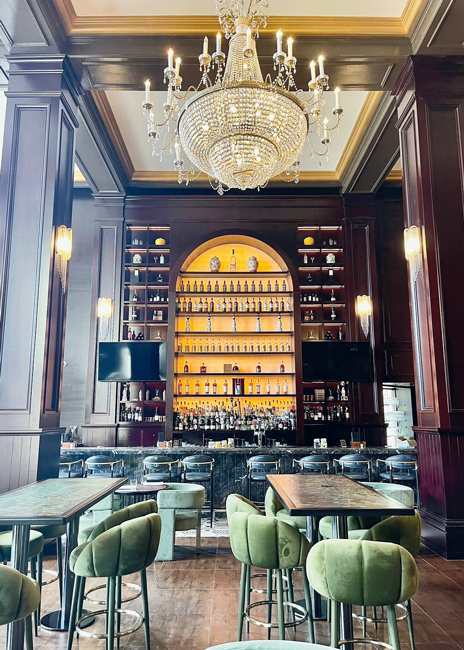 Woodes Rogers Tavern bar contains liquors in the arched display, along with shakers to prepare martinis and hand-crafted cocktails.Owner: China Construction America (CCA), a subsidiary of China State Construction Engineering Corp Ltd., which operates in North America and South America
Woodes Rogers Tavern bar contains liquors in the arched display, along with shakers to prepare martinis and hand-crafted cocktails.Owner: China Construction America (CCA), a subsidiary of China State Construction Engineering Corp Ltd., which operates in North America and South America
- Owner representatives: CCA International, U.S.
- Genguo Ju, vice president
- Kevin (Shiying) Sui, on-site project manager
- Karen (Tiantian) Kou, project manager
Hotel operator: Aimbridge Hotels
Interior design: Toni Hill Design, Nassau, the Bahamas: Antoinette McKinney, founder
General manager: Dan McDermott
Executive chef: Ignazio Podda
Executive sous chef: Antonio Williams
Pastry chef: Geshann Pratt
Foodservice design consultants: JME Design, Columbus, Ohio: John Egnor, managing partner; Ian Bushong, project manager; Spencer Ressa, project manager/designer; and independent consultant Michael Cloutier, Fort Meyers, Fla.
Equipment dealer: Stafford Smith, Kalamazoo, Mich.
Construction: CCA



